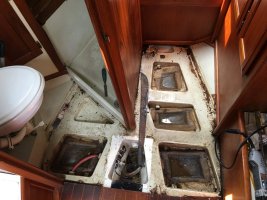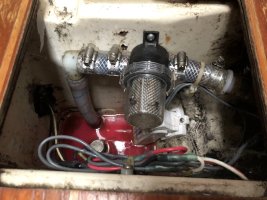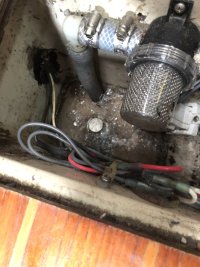Thanks Loren and Christian for the advice! I’ve cleaned out that filter twice already Loren - i need to do a thorough bilge cleaning. I’ve tried the method of motoring around with cleaner in the bilge but it’s not getting the job done. Time for a deeper dive.ps: regularly check the coarse filter in the little plastic housing that Jabsco provided that is located between the strum box and the pump. I suspect that some of us ignore it for years at a time. I will give props to EY for using wire-reinforced black 3/4 hose for the runs from those pumps.
You are using an out of date browser. It may not display this or other websites correctly.
You should upgrade or use an alternative browser.
You should upgrade or use an alternative browser.
water in the bilge
- Thread starter vasuvius
- Start date
One (I think only) drawback of the TAFG structure is that it traps water. It has limber holes and hidden conduits. Historical spills of oil or fuel reside in them for years until something wakes them up--often a full-bilge cleaning.
My model has drain plugs to drain the structure into the proper bilge. Others have drilled holes to free entrapped fluids. After my own tiny fuel and oil spills, I have had to insert a hand pump to draw out fluid that otherwise would remain there.
This boat was full of sawdust, as revealed by the mixmaster of gale conditions. I guess from furniture. Teak dust. Ancient.
A thorough cleaning of the hidden TAFG may require multiple floodings and pumpings, with a nice clear result obtained --until heeling and pitching wakes up some sleeping glop not roused by earlier reveilles.
A look under my floorboards shows a typical condition:

Those tabbed areas--ordinarily absolutely inaccessible without destroying the sole--are limbered, and connected for drainage by PVC tubes. The tubes were no doubt sealed in their entry and exit holes to prevent incursion into the TAGF structure, but that was a long time ago.
Water that defeats the limber tubes get into the structure itself , and is hard to get out.
It's not a critical flaw, but it does answer, at least for me, the question: how come I keep getting glop in my bilge?
My model has drain plugs to drain the structure into the proper bilge. Others have drilled holes to free entrapped fluids. After my own tiny fuel and oil spills, I have had to insert a hand pump to draw out fluid that otherwise would remain there.
This boat was full of sawdust, as revealed by the mixmaster of gale conditions. I guess from furniture. Teak dust. Ancient.
A thorough cleaning of the hidden TAFG may require multiple floodings and pumpings, with a nice clear result obtained --until heeling and pitching wakes up some sleeping glop not roused by earlier reveilles.
A look under my floorboards shows a typical condition:

Those tabbed areas--ordinarily absolutely inaccessible without destroying the sole--are limbered, and connected for drainage by PVC tubes. The tubes were no doubt sealed in their entry and exit holes to prevent incursion into the TAGF structure, but that was a long time ago.
Water that defeats the limber tubes get into the structure itself , and is hard to get out.
It's not a critical flaw, but it does answer, at least for me, the question: how come I keep getting glop in my bilge?
Last edited:
Prairie Schooner
Jeff & Donna, E35-3 purchased 7/21
I recall there was a point in the series where Jack Aubrey introduced this as a regular exercise for the crew of the Surprise.. . . A thorough cleaning of the hidden TAFG may require multiple floodings and pumpings, with a nice clear result obtained --until heeling and pitching wakes up some sleeping glop not roused by earlier reveilles.
. . .
A rusty machete is typical? Was that a found item or used for the demolition?A look under my floorboards shows a typical condition
Bolo
Contributing Partner
I have one centrifugal pump in the “main” bilge and one diaphragm pump that services the “mast/shower” bilge in my E32-3. Soon I hope to change out the centrifugal pump for a diaphragm pump because I think it is a better be it more expensive choice. The mast bilge always has some water in it because there is no way to stop rain water from coming into the boat on a keel stepped Ericson. Some things you can’t change you just have to live with and adapt. The centrifugal pump I had in the mast bilge worked ok getting the water out but as soon as it turned off all of the water left in the long run to the stern through hull flowed back into the bilge and if the float switch wasn’t properly located this could cause a recycling on and off of the pump. A one way valve was considered but the danger of a clogged valve put that out of my mind.
Instead I installed a Jabsco 37202 Series pump from Defender for about $230 and it’s worked without a problem. It’s installed under the cockpit helm seat, near the through hull, and in the bilge I installed a strainer, which is necessary because diaphragm pump can’t tolerate large particles to well. A hose runs from the strainer to a 90 degree elbow and down to the bottom of the bilge where the end of the hose is cut at a shadow angle which allows for most all of the water to be sucked out. That’s right, sucked, instead of pushed so that where I switch from auto to manual (switch is located in the head) almost all of the water is removed.
The pulsating diaphragm pump sounds like there’s a little man pounding away on a little drum in the stern of the boat but it gets the job done and there is no back flow if the water is all pumped out in manual mode. It is slower then a centrifugal pump but I agree with what has been written already on this string, these pumps are really made for removing rain water and maybe a small leak from a split hose. They will not save the boat from a catastrophic breech.
The first photo below shows the setup in the mast bilge right after I winterized it. But since the rain water from the mast can’t be stopped the antifreeze I added one recent winter diluted to the point where the water in the bilge, the hose and pump froze solid (2nd photo). To clear it I heated some antifreeze up on the stove and poured it into the bilge. After about an hour or so, trying the manual setting on the pump once in awhile, the line cleared and the pump was not damaged. I’m sold on diaphragm pumps and like I mentioned before, I’ll be changing out the main bilge centrifugal pump soon.


Instead I installed a Jabsco 37202 Series pump from Defender for about $230 and it’s worked without a problem. It’s installed under the cockpit helm seat, near the through hull, and in the bilge I installed a strainer, which is necessary because diaphragm pump can’t tolerate large particles to well. A hose runs from the strainer to a 90 degree elbow and down to the bottom of the bilge where the end of the hose is cut at a shadow angle which allows for most all of the water to be sucked out. That’s right, sucked, instead of pushed so that where I switch from auto to manual (switch is located in the head) almost all of the water is removed.
The pulsating diaphragm pump sounds like there’s a little man pounding away on a little drum in the stern of the boat but it gets the job done and there is no back flow if the water is all pumped out in manual mode. It is slower then a centrifugal pump but I agree with what has been written already on this string, these pumps are really made for removing rain water and maybe a small leak from a split hose. They will not save the boat from a catastrophic breech.
The first photo below shows the setup in the mast bilge right after I winterized it. But since the rain water from the mast can’t be stopped the antifreeze I added one recent winter diluted to the point where the water in the bilge, the hose and pump froze solid (2nd photo). To clear it I heated some antifreeze up on the stove and poured it into the bilge. After about an hour or so, trying the manual setting on the pump once in awhile, the line cleared and the pump was not damaged. I’m sold on diaphragm pumps and like I mentioned before, I’ll be changing out the main bilge centrifugal pump soon.


